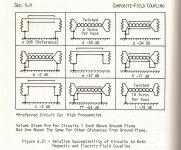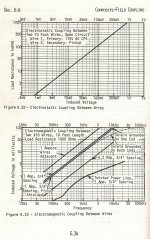I had an anally retentive room mate once who insisted on having all his cables for both his computer and his stereo system tied all nicely together with zip ties. AC cords and audio cables all nicely paralleled together in a tight little bunch. I had to explain to him what he was doing. He went on to work for AMP as a salesman selling multi-pin connectors to many industries, I hope he had learned his lesson about mixing ac power with signal by that time!
MC Step Up and Warp
John, I can´t find the original post right now, but somewhere in this thread
you said:
"1933, mumetal transformer 0.1V out, 10 ohm drive, 50K load, 10Hz distortion is 0.072%.
1931, Amorphous transformer 0.1V out, 10 ohm drive, 50K load, 10Hz distortion is 1.2%.
This is a distortion increase of about 20 times between the two units.
13.5 mV drive voltage.
Your distortion may vary.
I am going to REMOVE the transformer."
I´m not sure if 0.072% for a warped record would be something to worry about,
but OK, let´s assume we use an amorphous core. How would we ever arrive at
0.1 V output from the transformer ?
Three points that make such a scenario unplausible IMHO:
1) A correctly set up tonearm cartridge combination should have a
resonance frequency of 9-12 Hz, frequencies below that point should
be attenuated 12 dB / octave.
2) 100 mV out from the transformer at 10 Hz will be amplified
approx. 60 dB by the subsequent RIAA stage (assumed 40 dB gain at 1 kHz)
this will (theoretically) result in 100V output. Actually the phono
stage will clip way before this point and will deliver a 10 Hz square
wave (almost) which will make your speakers disintegrate rather quickly.
3) A record which produces this amount of warp is not playable if it
exist at all.
John, I can´t find the original post right now, but somewhere in this thread
you said:
"1933, mumetal transformer 0.1V out, 10 ohm drive, 50K load, 10Hz distortion is 0.072%.
1931, Amorphous transformer 0.1V out, 10 ohm drive, 50K load, 10Hz distortion is 1.2%.
This is a distortion increase of about 20 times between the two units.
13.5 mV drive voltage.
Your distortion may vary.
I am going to REMOVE the transformer."
I´m not sure if 0.072% for a warped record would be something to worry about,
but OK, let´s assume we use an amorphous core. How would we ever arrive at
0.1 V output from the transformer ?
Three points that make such a scenario unplausible IMHO:
1) A correctly set up tonearm cartridge combination should have a
resonance frequency of 9-12 Hz, frequencies below that point should
be attenuated 12 dB / octave.
2) 100 mV out from the transformer at 10 Hz will be amplified
approx. 60 dB by the subsequent RIAA stage (assumed 40 dB gain at 1 kHz)
this will (theoretically) result in 100V output. Actually the phono
stage will clip way before this point and will deliver a 10 Hz square
wave (almost) which will make your speakers disintegrate rather quickly.
3) A record which produces this amount of warp is not playable if it
exist at all.
Last edited:
this translates to 4 microvolts.
More oww than wow, imo.
Poor keyboard technique just ate my post! But short story is bundling cables, in this one case in automotive the speaker-amp wires with the power windows, led to a last-minute disaster with the Lincoln Continental Mark VI (?) in which operation of the power windows momentarily shut down all the audio.I had an anally retentive room mate once who insisted on having all his cables for both his computer and his stereo system tied all nicely together with zip ties. AC cords and audio cables all nicely paralleled together in a tight little bunch. I had to explain to him what he was doing. He went on to work for AMP as a salesman selling multi-pin connectors to many industries, I hope he had learned his lesson about mixing ac power with signal by that time!
The remedy was a plethora of schottky diodes clamping negative excursions of the BTL chip amp outputs, and one diode which I found by trial and error and which David McCorkle thereafter referred to as the Brad Wood Magic Diode.
1 Hz distortion ? Why would it matter ?
I'd think at most only for IM distortion. If indeed the cartridge output is anywhere near sufficient.
But directly at the input, in this case of a high stepup ratio transformer, with an MC cartridge I should think the signals are still pretty tiny.Warp induced phono output peaks broadly around 4 Hz, and arm mass / suspension compliance with a Q in the single digits is typically 8 to 12 Hz. All is boosted by RIAA curve.
Thanks,
Chris
My audiophile friend Don likes transformers, but only when they are very good and so far in his experience very expensive. So for a mid-priced hybrid preamp he favored JFETs for the pre-pre. He had rolled a simple single 2SK170 battery-powered stage once and thought it sounded about as good or better than a commercial highend MC stage, and wanted to know what was wrong with that. I listed about 6 prominent objections
Maybe You could try phono pre out?
At 4 microvolts (generously!)? Look at a scope, John (and at these levels, you'll see nothing).
You made a poor argument, get over it and move on.
Maybe You could try phono pre out?
If it were worth it (i.e., there was any plausibility), I would. There isn't. No data and the hand-wave fails the simplest analysis.
Besides which, my preamp doesn't go down to 1Hz, nor do most phono preamps (and they shouldn't!).
1 Hz distortion ? Why would it matter ?
Especially after the FM modulation of everything. I wonder if anyone has put this into the context of stereo FM cross-modulation? The perfect sound you know.
Appreciate the straightforward discussion, Dick. It's useful for all of us.
Here is some data which helps put things into a proper context and perspective re. cable and interference rejection; data regarding electrostatic and magnetic -test freq is 100KHz: Note how grounding - as well as cable configuration - can affect the performance -


[data from my library -> Electromagnetic Interference and Compatibility VOL.3. EMI Control Methods and Techniques. By Don J.R.White and Assoc]
Thx-RNMarsh
Last edited:
My audiophile friend Don likes transformers, but only when they are very good and so far in his experience very expensive. So for a mid-priced hybrid preamp he favored JFETs for the pre-pre. He had rolled a simple single 2SK170 battery-powered stage once and thought it sounded about as good or better than a commercial highend MC stage, and wanted to know what was wrong with that. I listed about 6 prominent objections
Most prominent I hope is the lack of pain, without which we (blah, blah, blah).
Iron-cored transformers have a flat spot through zero crossing in the B-H curve. Should be ignorable for a low-Z source and a high-Z load, but I wonder if there's some way to quantify this, or at last put it to bed.
Thanks,
Chris
- Status
- Not open for further replies.
- Home
- Member Areas
- The Lounge
- John Curl's Blowtorch preamplifier part II